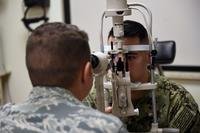 Volunteer Force: Middle-Class U.S. With Southern Drawl - A new “Population Representation” report on the U.S. military affirms that the four-decade-old volunteer force is a healthy cross-section of America, if just a little smarter, a little better educated and with a deeper southern drawl than the nation as a whole. The percentage of female enlisted members has declined slightly over the past decade, to 14.5 percent, reflecting lower wartime retention rates, while the percentage of female officers continued to climb past 17 percent. The racial, ethnic and socioeconomic mix is not too different from America itself. Among recent recruits, blacks are slightly over-represented, at 18.7 percent versus 15.5 percent of recruit-age youth. But the report notes important gains for blacks across the career enlisted force. “Contrary to what one might expect,” it says, “black service members are underrepresented among junior enlisted pay grades (relative to whites) but overrepresented in the senior pay grades. This is particularly true for the top enlisted leadership positions (E8 and E9). It reflects both strong black accession percentages in the 1990s and black service members’ high continuation rates and competitiveness in the promotion process.” The number of Hispanics in uniform is climbing, though not at a pace to match Hispanic population growth nationwide. In 1978, the report notes, Hispanics were 6.1 percent of accessions; by 2013 they were 15.5 percent, still short of 21.1 percent Hispanics among all recruit-age youth. Asians are the fastest growing ethnic group in the U.S. but their recruit numbers lag. They were 5.4 percent of recruit-age youth in 2013 but 3.8 percent of non-prior service accessions. Congress has required an annual report on the composition of the armed forces since 1974, the year after conscription ended. This year’s report, prepared for the Department of Defense by CNA Corp., analyzes fresh data compiled by the Defense Manpower and Data Center through fiscal 2013. It explains how the mix of volunteers has changed over time and why recruit quality, recently at an all-time high, likely won’t stay there. The full report is online at: http://www.cna.org/pop-rep with a lot more detail on both active and reserve components. In 2013 all service branches, including the Coast Guard, met recruiting goals, taking “high percentages of high-quality recruits” and significantly exceeding their own goals, CNA officials noted in releasing the report. “We cannot expect such good news in the future,” it warns, because recruiting success “is closely tied to the state of the economy. In 2013 the unemployment rate was 7.4 percent (15.5 percent among those 16 to 24 years old) and it was difficult to find employment.” The jobless rate now is 5.8 percent, lowest in six years. “As the economy continues to expand we can expect recruiting to get tougher and tougher,” CNA warns. As of Sept. 30, 2013, active duty strength stood at 1.37 million, down 41,000 over the previous two years. That was 600,000 fewer enlisted than were on active duty in 1973 when the draft ended. The Marine Corps, smallest of Department of Defense services, had the same number of active duty members in 2013 (196,000) as it did 40 years earlier. Yet over that period, Army active duty strength fell 63 percent, to 528,000; Navy strength fell 54 percent, to 320,000; and Air Force dropped by 46 percent, to under 327,000. The all-volunteer force is far more senior than during the draft-era when skills were less technical and services needed fewer careerists. The services were flush with quality recruits from 2011 through 2013 due not only to a poor economy but a post-war drawdown that allowed the Army and Marine Corps, in particular, to be more selective than in the past. Recruits are deemed high quality if they have at least a high school diploma and entrance exam scores that are at or above the 50th percentile of test scores nationwide. In 2013, the proportion of high-quality recruits was 96 percent for Air Force and Coast Guard, 82 percent for Navy, 72 percent for Marine Corps and 61 percent for Army. Recruiters worry that every year a smaller slice of the nation’s youth qualify for service. In 2013, only 13 percent were both available (not in college) and could meet recruiting standards without a waiver. An estimated 22 percent of youth would be disqualified for medical issues, 21 percent are overweight, 14 percent have mental issues and 8 percent used illegal drugs. To assess how recruits track on a socioeconomic scale, the report uses census data to divide the nation into five strata of affluence, from poorest to wealthiest areas. It found most recruits hail from the three middle-income quintiles and under represent poorest and wealthiest neighborhoods. Fewer recruits from lowest income areas “are likely explained” by military educational and aptitude test scores requirements, the report explains. Lower representation from highest income neighborhoods “is probably due to higher college attendance rates…in those census tracts.” The military continues to recruit most heavily from southern states while youth of northeastern states are underrepresented based on the relative size of their recruit-age populations (18 to 24). Georgia and then Florida topped an “accession share” list, providing 47 and 44 percent more recruits, respectively, above their youth populations. Other states sending at least 25 percent more recruits than expected are Idaho, Virginia, South Carolina, Maine, Arizona, Hawaii and Alabama. Ten states that provide fewer recruits than expected given their youth numbers are: North Dakota, Massachusetts, Utah, New Jersey, Rhode Island, Connecticut, New York, South Dakota, Kentucky and Iowa. The District of Columbia provides the smallest proportion recruits in the nation. The disparities reflect several factors including local qualification rates for military service, propensity to enlist and the level of recruiting resources the services commit to each state. To comment, write Military Update, P.O. Box 231111, Centreville, VA, or email milupdate@aol.com or twitter: Tom Philpott @Military_Update # # # # Tom Philpott has been breaking news for and about military people since 1977. After service in the Coast Guard, and 17 years as a reporter and senior editor with Army Times Publishing Company, Tom launched "Military Update," his syndicated weekly news column, in 1994. "Military Update" features timely news and analysis on issues affecting active duty members, reservists, retirees and their families. Visit Tom Philpott's Military Update Archive to view his past articles. Tom also edits a reader reaction column, "Military Forum." The online "home" for both features is Military.com.
Volunteer Force: Middle-Class U.S. With Southern Drawl - A new “Population Representation” report on the U.S. military affirms that the four-decade-old volunteer force is a healthy cross-section of America, if just a little smarter, a little better educated and with a deeper southern drawl than the nation as a whole. The percentage of female enlisted members has declined slightly over the past decade, to 14.5 percent, reflecting lower wartime retention rates, while the percentage of female officers continued to climb past 17 percent. The racial, ethnic and socioeconomic mix is not too different from America itself. Among recent recruits, blacks are slightly over-represented, at 18.7 percent versus 15.5 percent of recruit-age youth. But the report notes important gains for blacks across the career enlisted force. “Contrary to what one might expect,” it says, “black service members are underrepresented among junior enlisted pay grades (relative to whites) but overrepresented in the senior pay grades. This is particularly true for the top enlisted leadership positions (E8 and E9). It reflects both strong black accession percentages in the 1990s and black service members’ high continuation rates and competitiveness in the promotion process.” The number of Hispanics in uniform is climbing, though not at a pace to match Hispanic population growth nationwide. In 1978, the report notes, Hispanics were 6.1 percent of accessions; by 2013 they were 15.5 percent, still short of 21.1 percent Hispanics among all recruit-age youth. Asians are the fastest growing ethnic group in the U.S. but their recruit numbers lag. They were 5.4 percent of recruit-age youth in 2013 but 3.8 percent of non-prior service accessions. Congress has required an annual report on the composition of the armed forces since 1974, the year after conscription ended. This year’s report, prepared for the Department of Defense by CNA Corp., analyzes fresh data compiled by the Defense Manpower and Data Center through fiscal 2013. It explains how the mix of volunteers has changed over time and why recruit quality, recently at an all-time high, likely won’t stay there. The full report is online at: http://www.cna.org/pop-rep with a lot more detail on both active and reserve components. In 2013 all service branches, including the Coast Guard, met recruiting goals, taking “high percentages of high-quality recruits” and significantly exceeding their own goals, CNA officials noted in releasing the report. “We cannot expect such good news in the future,” it warns, because recruiting success “is closely tied to the state of the economy. In 2013 the unemployment rate was 7.4 percent (15.5 percent among those 16 to 24 years old) and it was difficult to find employment.” The jobless rate now is 5.8 percent, lowest in six years. “As the economy continues to expand we can expect recruiting to get tougher and tougher,” CNA warns. As of Sept. 30, 2013, active duty strength stood at 1.37 million, down 41,000 over the previous two years. That was 600,000 fewer enlisted than were on active duty in 1973 when the draft ended. The Marine Corps, smallest of Department of Defense services, had the same number of active duty members in 2013 (196,000) as it did 40 years earlier. Yet over that period, Army active duty strength fell 63 percent, to 528,000; Navy strength fell 54 percent, to 320,000; and Air Force dropped by 46 percent, to under 327,000. The all-volunteer force is far more senior than during the draft-era when skills were less technical and services needed fewer careerists. The services were flush with quality recruits from 2011 through 2013 due not only to a poor economy but a post-war drawdown that allowed the Army and Marine Corps, in particular, to be more selective than in the past. Recruits are deemed high quality if they have at least a high school diploma and entrance exam scores that are at or above the 50th percentile of test scores nationwide. In 2013, the proportion of high-quality recruits was 96 percent for Air Force and Coast Guard, 82 percent for Navy, 72 percent for Marine Corps and 61 percent for Army. Recruiters worry that every year a smaller slice of the nation’s youth qualify for service. In 2013, only 13 percent were both available (not in college) and could meet recruiting standards without a waiver. An estimated 22 percent of youth would be disqualified for medical issues, 21 percent are overweight, 14 percent have mental issues and 8 percent used illegal drugs. To assess how recruits track on a socioeconomic scale, the report uses census data to divide the nation into five strata of affluence, from poorest to wealthiest areas. It found most recruits hail from the three middle-income quintiles and under represent poorest and wealthiest neighborhoods. Fewer recruits from lowest income areas “are likely explained” by military educational and aptitude test scores requirements, the report explains. Lower representation from highest income neighborhoods “is probably due to higher college attendance rates…in those census tracts.” The military continues to recruit most heavily from southern states while youth of northeastern states are underrepresented based on the relative size of their recruit-age populations (18 to 24). Georgia and then Florida topped an “accession share” list, providing 47 and 44 percent more recruits, respectively, above their youth populations. Other states sending at least 25 percent more recruits than expected are Idaho, Virginia, South Carolina, Maine, Arizona, Hawaii and Alabama. Ten states that provide fewer recruits than expected given their youth numbers are: North Dakota, Massachusetts, Utah, New Jersey, Rhode Island, Connecticut, New York, South Dakota, Kentucky and Iowa. The District of Columbia provides the smallest proportion recruits in the nation. The disparities reflect several factors including local qualification rates for military service, propensity to enlist and the level of recruiting resources the services commit to each state. To comment, write Military Update, P.O. Box 231111, Centreville, VA, or email milupdate@aol.com or twitter: Tom Philpott @Military_Update # # # # Tom Philpott has been breaking news for and about military people since 1977. After service in the Coast Guard, and 17 years as a reporter and senior editor with Army Times Publishing Company, Tom launched "Military Update," his syndicated weekly news column, in 1994. "Military Update" features timely news and analysis on issues affecting active duty members, reservists, retirees and their families. Visit Tom Philpott's Military Update Archive to view his past articles. Tom also edits a reader reaction column, "Military Forum." The online "home" for both features is Military.com.  Tom's freelance articles have appeared in numerous magazines including The New Yorker, Reader's Digest and Washingtonian. His critically-acclaimed book, Glory Denied, on the extraordinary ordeal and heroism of Col. Floyd "Jim" Thompson, the longest-held prisoner of war in American history, is available in hardcover and paperback. Buy Glory Denied from Amazon
Tom's freelance articles have appeared in numerous magazines including The New Yorker, Reader's Digest and Washingtonian. His critically-acclaimed book, Glory Denied, on the extraordinary ordeal and heroism of Col. Floyd "Jim" Thompson, the longest-held prisoner of war in American history, is available in hardcover and paperback. Buy Glory Denied from Amazon
© Copyright 2024 Military.com. All rights reserved. This article may not be republished, rebroadcast, rewritten or otherwise distributed without written permission. To reprint or license this article or any content from Military.com, please submit your request here.



